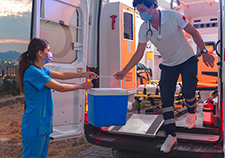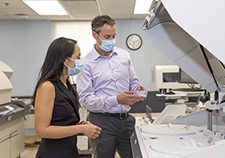Office of Research & Development |
 |
The kidneys are a pair of fist-sized organs located on either side of the spine. Kidneys perform many life-sustaining functions. They remove waste products, toxins, and excess fluid that build up in the body. The kidneys are essential for maintaining a safe level of chemicals in the bloodstream, including potassium, sodium, and phosphorus. They also help to control blood pressure.
Together, kidney diseases are the ninth leading cause of death in the United States, according to the Centers for Disease Control and Prevention. Kidney disease or injury can happen suddenly and may get better over time. This condition is called acute kidney injury (AKI), and happens most often in critically ill people who are hospitalized.
About 37 million American adults are estimated to have chronic kidney disease (CKD), a condition that develops slowly over time. In CKD, the kidneys become damaged and cannot filter blood adequately. People are at greater risk of developing CKD if they have diabetes, high blood pressure, or heart disease. African Americans, Hispanic Americans, and American Indians also have a greater risk of developing CKD.
Most people who have CKD are unaware that they have the disease. Approximately 500,000 Veterans who receive their health care from VA have CKD. Of this group, roughly 22,000 are on dialysis.
Early kidney disease has few symptoms. As the disease progresses, people can experience swelling, fatigue, dry skin, and nausea, among other symptoms. Complications of advanced kidney disease can include high blood pressure, arteriosclerosis (thickening of the arteries), anemia, and weakened bones. Advanced disease can also result in kidney failure—once this happens, people must start dialysis or seek a kidney transplant to survive. However, most people with CKD do not require dialysis.
VA offers free web-based education on kidney disease and treatment through the VA eKidney Clinic, the VA Mobile Kidney App (currently in beta testing), and the Veterans Health Library.
Heartwarming Innovation
The VA's commitment to cutting-edge research establishes a continuum of innovations that are nothing short of life-saving. From the first successful human liver transplant to the invention of the warm perfusion organ storage technology, the VA has changed the landscape of organ transplants to one that saves countless lives.
VA has a comprehensive research portfolio aimed at prevention and improving treatment for both acute and chronic kidney disease. There are many causes of chronic kidney disease, but the two main ones are diabetes and high blood pressure, which account for up to two-thirds of all cases.
The VHA National Kidney Program’s mission is to improve the quality of health care services delivered to Veterans with kidney disease. The program supplies kidney-related services to VA dialysis centers and provides health care providers with education, research, and informatics resources. VA kidney specialists are dedicated to expanding the understanding of kidney disease and its impact on Veterans. They also contribute to the development of new treatments to help patients manage disease symptoms.
A map of VA dialysis facilities is available here.
In 2019, VA investigator Dr. Michael J. Shlipak received the John B. Barnwell award for pioneering the use of a new biochemical measure, cystatin C, to detect early kidney disease. His research has also shown that cystatin C is also a marker for high risk of developing heart and vascular disease. The Barnwell Award is VA Clinical Science Research and Development’s highest honor.
If you are interested in learning about joining a VA-sponsored clinical trial, visit our research study information page.
Dr. Thomas E. Starzl (1926-2017) was a VA transplant surgeon and research scientist for more than 50 years. He began his VA career in the 1950s at the Chicago VA medical center and later served at the Denver and Pittsburgh VA medical centers.
In 1962, while on the staff at Denver VA and the University of Colorado Medical Center, Starzl conducted the first in a series of kidney transplants that consistently resulted in long-term survival for patients. He used azathioprine and prednisone, immunosuppressant drugs, to keep the body from rejecting a new kidney. While he was not the first surgeon to perform a successful kidney transplant, Starzl is credited with the "first-ever series of repetitively successful human kidney transplantations."
Widely regarded as the "father of transplantation," Starzl is also credited with performing the first successful liver transplant in 1963. No patient had survived the operation previously. While Starzl's patient died from pneumonia weeks after surgery, the procedure was still considered groundbreaking and paved the way for successful liver transplantation. In 1967, Starzl performed the first successful liver transplant with a patient surviving more than a year.
Starzl spent much of his career working on anti-rejection medications that would markedly increase transplant survival rates. In 2011, he received the prestigious Lasker-DeBakey Clinical Medical Research Award for his career accomplishments. As of 2021, he is one of seven VA researchers to have earned the honor.
Today, VA performs more than 150 kidney transplants every year. Eligible Veterans can receive services through the National VA Transplant Program. Veterans may also receive transplant services through community transplant centers if they meet VA’s community care eligibility criteria.
AKI, also called acute kidney failure, is a sudden loss of kidney function that develops within 48 hours. AKI is most common in critically ill patients—it can be caused by disease, infection, trauma, certain drugs, and other conditions.
AKI in Veterans with COVID-19—AKI is common in Veterans hospitalized with COVID-19, especially Black Veterans, according to a 2020 study by investigators at the VA St. Louis Health Care System and Washington University.
The team analyzed date from 5,216 VA patients admitted with COVID-19 between March and July 2020. Of those Veterans, 32% had AKI. Those with AKI were 6.5 times more likely than their peers to require mechanical ventilation and stayed in the hospital an additional 5.6 days. They were also 6.7 times more likely to die of their illness, a link that was particularly strong in Black patients.
Eight percent of Veterans with AKI developed it in their first day of hospitalization, and 47% still had kidney dysfunction after they were released from the hospital. Other factors predisposing COVID-19 patients to AKI included older age, male sex, obesity, diabetes, high blood pressure, and lower kidney function. The team noted that racial disparities likely reflect differences in exposure to social, economic, environmental, and other stressors that create a higher risk of AKI.
Predicting AKI using computers—In 2019, researchers from VA and Alphabet, the parent company of Google, demonstrated that software could predict the development of AKI in patients up to 48 hours before it occurred.
The machine learning software, developed by Alphabet’s DeepMind project, was trained using medical records from more than 700,000 VA patients. It was able to predict 90% of AKI cases in which kidney damage was severe enough to require dialysis.
The results suggest physicians could one day get early warnings from computer software that will keep their patients from suffering permanent kidney damage.
The kidneys eliminate waste products and extra fluid in the body through the urinary system. When they are not working properly, wastes build up in the blood. A diagnosis of CKD means that the patient's kidneys have not been working properly for some time.
HIV drug may increase kidney disease and fractures—A common treatment for HIV is associated with higher odds of CKD and bone fractures, according to a 2020 study by researchers at the W.J.B. Dorn VA Medical Center in Columbia, South Carolina, and the University of South Carolina.
Among 5,000 VA patients with HIV, those taking the drug tenofovir disoproxil fumarate (sold as Viread) had 48% higher odds of developing CKD. They also had more than twice the risk of bone fracture due to deterioration or low bone mass.
HIV regimens using this drug have been associated with impaired kidney function and loss of bone mineral density in the past. The results of this study shed a light on the extent of this association.
Heartburn drugs can cause CKD—Heartburn drugs called proton pump inhibitors (PPIs), such as Prilosec, can cause increased levels of CKD and cardiovascular disease, according to a 2019 study at the VA St. Louis Health Care System and Washington University School of Medicine.
The researchers compared more than 157,000 Veterans who used PPIs and nearly 57,000 Veterans who used H2 blockers, such as Pepcid, for acid suppression. Over a 10-year period, the researchers found 45 excess deaths for every 1,000 users of PPIs, with most of the deaths resulting from cardiovascular disease or CKD.
According to the study authors, people should still take PPIs when they need them, but the drugs should be taken at the lowest effective dose and for the shortest period of time possible.
Older patients who choose to forgo dialysis—Older adults who do not want to undergo dialysis often encounter resistance from their doctors, according to a study at the VA Puget Sound Health Care System and the University of Washington.
A 2019 study reviewed medical records for 851 Veterans, with a mean age of 75 years, who refused dialysis. Maintenance dialysis involves both risks and benefits for patients. Researchers found physicians were resistant to Veterans' decisions not to initiate treatment. Doctors often speculated that these patients were mentally incompetent, depressed, or suicidal.
Researchers identified an "all-or-nothing" approach to dialysis from physicians—they recommended that care teams should solicit patient goals concerning renal care. The research team believes stronger efforts should be devoted to developing patient-centered models of care for patients with advanced CKD.
Kidney stones are mineral deposits that form inside the kidneys. Diet, excess weight, certain medical conditions, and medications are among the many causes of kidney stones. It can be very painful to pass kidney stones through the urinary system.
How kidney stones form—In 2021, researchers at the VA Calcium Signaling Laboratory found that acidosis in the body can lead to the formation of kidney stones. A region of the kidney called the proximal tubule helps control the balance between acids and bases in the blood. Acidosis occurs when acids are not properly removed from the blood and excreted into the urine. This causes the urine to become more alkaline.
In a mouse model, the research team found that this shift in urine alkalinity causes a buildup of calcium ions, which may form into stones. In addition, when the proximal tubule does not function properly, it can cause cellular damage, which can lead to further stone formation.
Amino acid protects kidneys—In a 2019 study, researchers found an amino acid called L-ornithine may help reverse kidney damage. They tested the effects of this amino acid on proximal tubular cells and found it activated a protective protein called a calcium-sensing receptor. When activated, the receptor stopped harmful chemicals, called reactive oxygen species, from being produced. The team believes that L-ornithine could be useful in reversing kidney diseases involving proximal tubular cellular damage.
Plastic dishware contributes to stone formation—In a 2019 study, researchers found that melamine can sometimes find its way into the body through the use of products like plastic tableware. Melamine from plastic plates, cups, and utensils can leak into food when exposed to acids or high temperatures.
Melamine can promote the formation of calcium phosphate and calcium oxalate crystals—substances that make up kidney stones. The research team demonstrated that melamine acts on a protein that senses extracellular calcium in the kidneys, called the calcium sensing receptor, and thereby causes cell damage.
Kidney stones linked with bone problems—A 2021 study by researchers at the VA Palo Alto Health Care System and Stanford University identified more than 500,000 Veterans treated in VA who had kidney stones during the period 2007-2015. The researchers found that approximately 24% of study participants had a diagnosis of osteoporosis (brittle bones) or bone fracture. Twenty percent of the Veterans who were screened following their kidney stone diagnosis also had osteoporosis.
The findings support wider use of bone density screenings in individuals with kidney stones, including middle-aged and older men who may not be recognized as being at risk for osteoporosis or fracture.
Phone-based kidney care effective for Black patients with diabetes—A telehealth intervention more effectively slowed kidney decline caused by diabetes in African Americans than in non-African Americans. The 2020 study was conducted by researchers at the Durham VA Medical Center and Duke University.
Pharmacists delivered a phone-based intervention to patients with diabetic kidney disease that used behavioral modification and medication management. The results were compared with a control group who received disease education. Among African American patients, those who received telehealth had better eGFR levels, a measure of kidney function, than those who received education. The difference between the telehealth group and the control group was significantly greater in African Americans than in non-African Americans. The results suggest that African Americans may respond better to a multifactorial telehealth approach to diabetic kidney disease care than other groups.
Rural and urban Veterans have similar wait times for kidney transplants—In 2019, researchers at the Iowa City VA Medical Center found that Veterans who lived in rural versus urban areas had no significant difference in how long they waited for a VA kidney transplant after being placed on a waitlist.
The team looked at data on more than 3,000 Veterans and more than 455,000 non-Veterans waitlisted for a transplant. Veterans receiving care at VA were older and more likely to be male or diabetic, compared to non-Veterans. They were also less likely to live in urban areas. Researchers found that urban Veterans spent a longer time on dialysis before registering for a transplant than rural Veterans.
Dialysis patients have lower mortality at VA—A 2018 study of nearly 70,000 patients found that patients who initiated dialysis at VA facilities had lower mortality than those at non-VA dialysis centers. VA patients had a 13% lower risk of death in the 12 months after they began dialysis, according to researchers at the VA Long Beach Healthcare System and the University of California.
Patients at VA facilities were more likely to be hospitalized within the first 12 months following dialysis initiation, but had lower all-cause mortality risk. The research team hypothesized VA’s integrated system of care may mean that patients receive more intense care for their health problems and have better access to inpatient services.
Older Veterans with advanced kidney disease do better at VA than with Medicare—Veterans who received medical care for kidney failure through VA were less likely to start dialysis than those who received care through Medicare, according to a 2018 study.
Researchers at the VA Palo Alto Health Care System in California and colleagues analyzed data from VA, Medicare, and the U.S. Renal Data System on more than 11,000 Veterans aged 67 years or older who had kidney failure. They found that Veterans treated for kidney disease in VA typically start dialysis later than those who are treated through Medicare. Nearly 82% of patients in the study who received pre-dialysis care through Medicare started dialysis within two years. In the VA group, only 53% of Veterans started dialysis within two years.
Despite receiving dialysis less often, Veterans treated through VA were less likely to die than those who received care through Medicare. VA’s integrated health care system appears to support less-intensive treatment for kidney failure without increasing mortality, researchers noted. VA physicians also do not have a financial incentive to start dialysis, in contrast to some non-VA physicians.
Risk of death after kidney transplant significantly lower in patients using VA care—In 2021, a team of researchers at the Pittsburgh VA Medical Center published a study that found the risk of death after a kidney transplant was significantly lower in patients whose post-surgery care was through VA, compared with centers outside VA.
The study focused on data from more than 6,000 Veterans enrolled in both VA health care and Medicare. Patients who used only non-VA post-transplant care were more than twice as likely to die within five years of their surgery, compared with patients who only used VA. Patients who used both VA and Medicare were 1.5 times more likely to die within five years compared to VA-only patients.
National estimates of CKD prevalence and potential impact of estimating glomerular filtration rate without race. Duggal V, Thomas I-C, Montez-Rath ME, Chertow GM, Tamura MK. Removal of race adjustments would double the estimated prevalence of CKD among Black adults in the United States. J Am Soc Nephrol. 2021 Jun 1;32(6):1454-1463.
Osteoporosis, fractures, and bone mineral density screening in Veterans with kidney stone disease. Ganesan C, Thomas I-C, Romero R, Song S, Conti S, Elliot C, Chertow GM, Tamura MK, Leppert JT, Pao AC. Approximately one-quarter of Veterans with kidney stones had a diagnosis of osteoporosis or bone fracture around the time of their kidney stone diagnosis. J Bone Miner Res. 2021 May;36(5):872-878.
Modulation of tubular pH by acetazolamide in a Ca 2+ transport deficient mice facilitates calcium nephrolithiasis. Boadi EA, Shin S, Yeroushalmi S, Choi BE Li P, Bandyopadhyay BC. The proximal tubule can cause acidosis, leading to the formation of kidney stones. Intl J Mol Sci. 2021 Mar 17;22(6):3050.
Source of post-transplant care and mortality among kidney transplant recipients dually enrolled in VA and Medicare. Cashion W, Gellad WF, Sileanu FE, Mor MK, Fine MJ, Hale J, Hall DE, Rogal S, Switzer G, Ramkumar M, Wang V, Bronson DA, Wilson M, Gunnar W, Weisbord SD. Most dually enrolled veterans underwent transplantation at a non-Veterans Health Administration transplant center using Medicare, yet many relied on Veterans Health Administration for some or all of their post-transplant care. Veterans who received Veterans Health Administration-only post-transplant care had the lowest 5-year mortality. Clin J Am Soc Nephrol. 2021 Mar 8;16(3):437-445.
Clinical outcomes of warfarin initiation in advanced chronic kidney disease patients with incident atrial fibrillation. Agarwal MA, Potukuchi PK, Sumida K, Naseer A, Molnar MZ, George LK, Koshy SK, Streja E, Thomas F, Kalantar-Zadeh K, Kovesdy CP. In patients with late-stage CKD who transitioned to dialysis, warfarin use was associated with higher risk of ischemic and bleeding events but a lower risk of mortality. JACC Clin Electrophysiol. 2020 Dec 14;6(13):1658-1668.
Acute kidney injury in a national cohort of hospitalized US Veterans with COVID-19. Bowe B, Cai M, Xie Y, Gibson AK, Maddukuri G, Al-Aly Z. AKI is common during hospitalization with COVID-19 and associated with higher risk of health care resource utilization and death. Clin J Am Soc Nephrol. 2020 Dec 31;16(1):14-25.
Racial differences in the effectiveness of a multifactorial telehealth intervention to slow diabetic kidney disease. Kobe EA, Diamantidis CJ, Bosworth HB, Davenport CA, Oakes M, Alexopoulos AS, Pendergast J, Patel UD, Crowley MJ. A multifactorial, pharmacist-delivered telehealth intervention for diabetic kidney disease may be more effective for slowing estimated glomerular filtration rate decline among African Americans than non-African Americans. Med Care. 2020 Nov;58(11):968-973.
Association of tenofovir disoproxil fumarate exposure with chronic kidney disease and osteoporotic fracture in US veterans with HIV. Sutton SS, Magagnoli J, Hardin JW, Hsu L-I, Beaubrun A, Majethia S, Cummings TH. In a large cohort of U.S. Veterans with HIV, current exposure to TDF was associated with a 48% higher odds of chronic kidney disease and a greater than two-fold increase in the odds of osteoporotic fracture. Curr Med Res Opin. 2020 Oct;36(10):1635-1642.
L-ornithine activates Ca 2+ signaling to exert its protective function on human proximal tubular cells. Shin S, Gombedza FC, Bandyopadhyay BC. The amino acid L-ornithine may help reverse kidney damage in kidney diseases involving proximal tubular cell damage. Cell Signal. 2020 Mar;67:109484.
Impact of rural residence on kidney transplant rates among waitlisted candidates in the VA transplant programs. O’Shea AMJ, Franciscus CL, Kaboli PJ, Kalil RS. Among waitlisted Veterans served by Veteran Health Administration transplant programs, residential rurality status does not portend longer waiting time for a kidney transplant. Transplantation. 2019 Sep;103(9):1945-1952.
A clinically applicable approach to continuous prediction of future acute kidney injury. Tomasev N, et al. Researchers developed a model for the continuous risk prediction of future deterioration from acute kidney injuries in patients. Nature. 2019 Aug;572(7767):116-119.
Estimates of all cause mortality and cause specific mortality associated with proton pump inhibitors among US veterans: cohort study. Xie Y, Bowe B, Yan Y, Xian H, Li T, Al-Aly Z. Taking proton pump inhibitors is associated with a small excess of cause-specific mortality including death due to cardiovascular disease, chronic kidney disease, and upper gastrointestinal cancer. BMJ. 2019 May 29;365:I1580.
Care practices for patients with advanced kidney disease who forgo maintenance dialysis. Wong SPY, McFarland LV, Liu CF, Laundry RJ, Hebert PL, O’Hare AM. Stronger efforts are needed to develop a more patient-centered approach to caring for patients with advanced CKD that is capable of proactively supporting those who do not wish to start dialysis. JAMA Intern Med. 2019 Mar 1;179(3):305-313.
Melamine promotes calcium crystal formation in three-dimensional microfluidic device. Gombedza F, Evans S, Shin S, Boadi EA, Zhang Q, Nie Z, Bandyopadhyay BC. The plastic melamine can contribute to the formation of kidney stones. Sci Rep. 2019 Jan 29;9(1):875.
Effect of intensive blood pressure lowering on kidney tubule injury: findings from the ACCORD trial study participants. Nadkarni GN, Chauhan K, Rao V, Ix JH, Shlipak MG, Parikh CR, Coca SG. Intensive blood pressure control was associated with reductions in estimated glomerular filtration rate, but not with an increase in injury marker levels. Am J Kidney Dis. 2019 Jan;73(1):31-38.
Effects of intensive blood pressure lowering on kidney tubule injury in CKD: a longitudinal subgroup analysis in SPRINT. Malhotra R, Craven T, Ambrosius WT, Killeen AA, Haley WE, Cheung AK, Chonchoi M, Sarnak M, Parikh CR, Shlipak MG, IX JH; SPRINT research group. Intensive blood pressure lowering is linked with reduction in estimated glomular filtration rate. Am J Kidney Dis. 2019 Jan;73(1):21-30.
Facility-level variations in kidney disease care among veterans with diabetes and CKD. Navaneethan SD, Akeroyd JM, Ramsey D, Ahmed ST, Mishra SR, Petersen LA, Muntner P, Ballantyne C, Winkelmayer WC, Ramanathan V, Virani SS. Among VA patients with diabetes and CKD, at facility-level, ordering of laboratory tests and scheduling of nephrology referrals in eligible patients remains suboptimal, with substantial variations across facilities. Clin J Am Soc Nephrol. 2018 Dec 7;13(12):1842-1850.
Dialysis versus medical management at different ages and levels of kidney function in veterans with advanced CKD. Tamura MK, Desai M, Kapphahn KI, Thomas I-C, Asch SM, Chertow GM. Providing dialysis at higher levels of kidney function may extend survival for some older patients. J Am Soc Nephrol. 2018 Aug;29(8):2169-2177.
Dialysis provider and outcomes among United States veterans who transition to dialysis. Streja E, Kovesdy CP, Soohoo M, Obi Y, Rhee CM, Park C, Chen JLGC, Nakata T, Nguyen DV, Amin AN, Jackobsen SJ, Sim JJ, Kalantar-Zadeh K. Veteran patients initiating dialysis with a VHA dialysis provider appear to have a lower mortality risk but higher hospitalization rates than veterans initiating dialysis at non-VHA dialysis units. Clin J Am Soc Nephrol. 2018 Jul 6;13(7):1055-1062.
Dialysis initiation and mortality among older Veterans with kidney failure treated in Medicare vs the Department of Veterans Affairs. Tamura MK, Thomas I-C, Montez-Rath ME, Kapphahn K, Desai M, Gale RC, Asch SM. Veterans who receive end-stage renal disease nephrology care in Medicare receive dialysis more often yet are also more likely to die within two years compared with those in VA. JAMA Intern Med. 2018 May 1;178(5):657-664.

Download PDF
 VA's new "burden-free" study method finds two blood pressure drugs equally effective
VA's new "burden-free" study method finds two blood pressure drugs equally effective
 Hep C-positive organs, safe and effective for most transplant recipients
Hep C-positive organs, safe and effective for most transplant recipients
 Researchers striving to improve detection of kidney disease in VA
Researchers striving to improve detection of kidney disease in VA